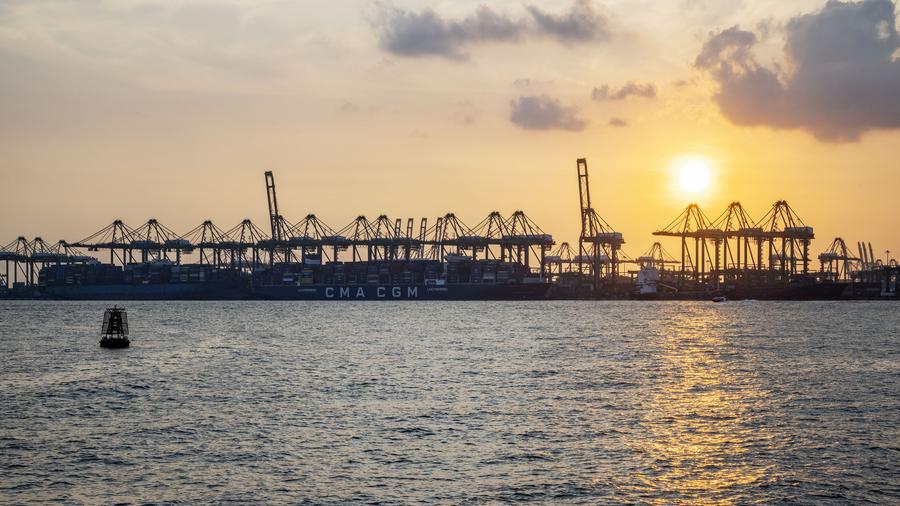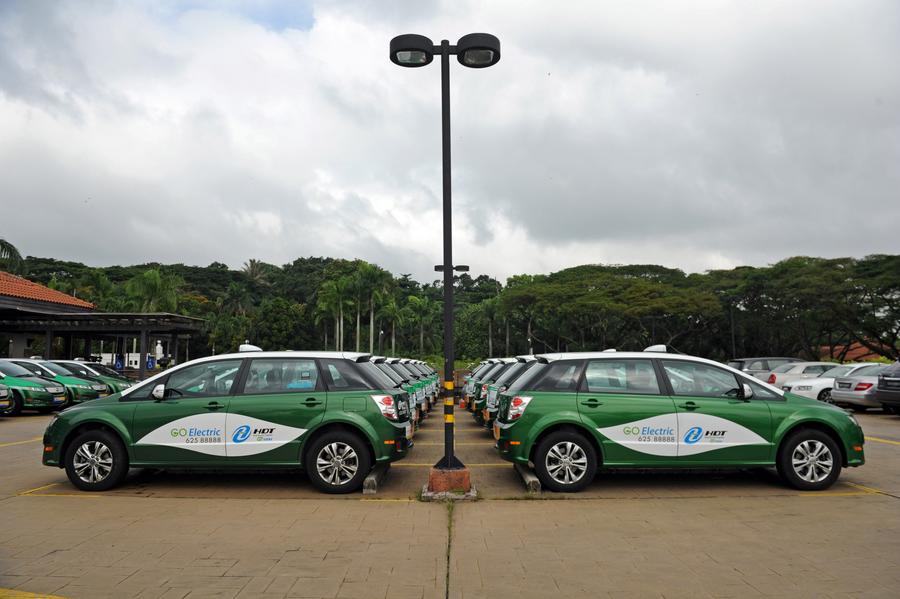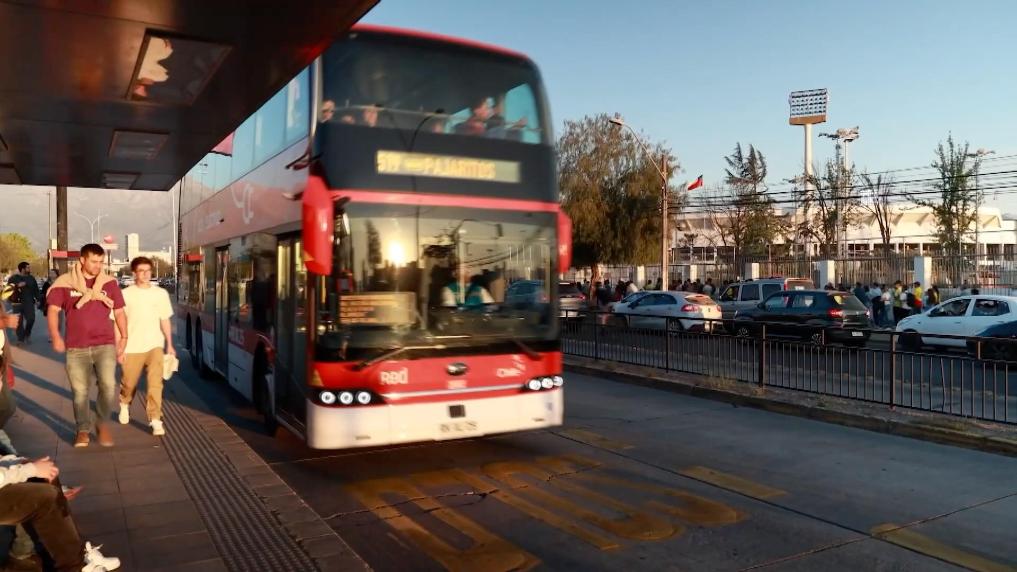Economic Watch: 35 years on, China-Singapore remain more forward-looking than ever
Source: Xinhua
Editor: huaxia
2025-10-25 21:01:15
As China pivots toward high-quality development and Singapore advances its "Smart Nation" vision, collaboration has expanded into emerging fields such as the digital economy, green energy, AI and new materials.
SINGAPORE, Oct. 25 (Xinhua) -- Three decades after its launch, the Suzhou Industrial Park in east China's Jiangsu Province, the first intergovernmental project between China and Singapore, has grown into a bustling industrial hub, contributing 400.24 billion yuan (56 billion U.S. dollars) to regional GDP in 2024.
Rising from a patch of muddy fields, its industrial base has continuously upgraded, expanding from low-end manufacturing into high-tech sectors such as biopharmaceuticals, nanotechnology and artificial intelligence (AI).
The park's growth underscores the enduring strength of China-Singapore collaboration, driving both countries' modernization. Marking 35 years of diplomatic relations, the two nations have deepened economic links: China has been Singapore's largest trading partner since 2013, while Singapore has remained China's top source of new foreign investment.
FROM INDUSTRIAL PARKS TO REGIONAL INTEGRATION
In February 1994, China and Singapore signed an agreement to establish the Suzhou Industrial Park. Over the years, the industrial park has attracted more than 5,200 foreign-funded projects, including 189 from 108 Fortune 500 companies, with foreign investment in actual use exceeding 42 billion dollars.
The park has also evolved from attracting investment to supporting overseas expansion. Shen Lei, deputy director of the park's management committee, said the Yangtze River Delta Overseas Investment Promotion Center established by the industrial park has helped more than 700 enterprises in the park invest and expand in over 60 countries and regions.
In 2008, collaboration extended north to the Bohai Rim region with the launch of the Sino-Singapore Tianjin Eco-City. Built on saline-alkali land and polluted waters, the project aimed to create a model for sustainable urban development. Seventeen years on, the Eco-City is home to over 260 plant species, up from 66 initially, while its low-carbon economy continues to expand, drawing green investment.
China-Singapore cooperation also deepened in connectivity. In 2015, the China-Singapore (Chongqing) Demonstration Initiative on Strategic Connectivity (CCI) was launched to link western China with Southeast Asia. Over the past decade, the initiative has produced 323 government and commercial agreements valued at 25.75 billion dollars.

It also resulted in the creation of the New International Land-Sea Trade Corridor -- a multimodal transportation network integrating rail, road and sea systems. It facilitated cross-regional collaboration between western Chinese provinces and Southeast Asian countries, and shortened transit time compared with eastern coastal routes. It now pulses with commercial vitality.
At a conference marking the 10th anniversary of the CCI in June, Singapore's Senior Minister of State for Digital Development and Information Tan Kiat How said the CCI exemplifies the strength of the Singapore-China partnership and their shared commitment to regional integration and innovation.
Tan said trade between ASEAN and China is expected to continue expanding, offering growing opportunities for trade and cross-border financing along the corridor.
Speaking ahead of his visit to China in June, Singaporean Prime Minister Lawrence Wong said, "The cooperation between our two countries, because of the close partnership, is never static. It never stands still. We are always upgrading, improving, trying to find new opportunities to cooperate and to be responsive to the needs of our times."
EXPLORING NEW ECONOMIC FRONTIERS
As China pivots toward high-quality development and Singapore advances its "Smart Nation" vision, collaboration has expanded into emerging fields such as the digital economy, green energy, AI and new materials.
The China-Singapore Guangzhou Knowledge City, launched in 2010, exemplifies this shift. Now home to more than 50,000 market entities with total registered capital exceeding 760.7 billion yuan (106.8 billion dollars), it has become a hub for biopharmaceuticals, integrated circuits and new-energy vehicles. Singapore's Foreign Ministry described it as "a key landing pad for Singapore companies to access the (Guangdong-Hong Kong-Macao) Greater Bay Area."
Science and technology cooperation underpins this growth. As early as 2018, Alibaba and the Nanyang Technological University (NTU) established a joint research institute focusing on AI. In September 2024, they launched the Alibaba-NTU Global e-Sustainability CorpLab, which plans to build a 200-member research team over five years to advance studies in 10 areas, including energy-efficient AI algorithms, sustainable living and digital technologies for aging and health.
Singapore's former Deputy Prime Minister Heng Swee Keat said that such corporate labs have an important role in Singapore's research, innovation and enterprise ecosystem.
Green transition is another key focus. In recent years, Chinese renewable energy firms such as Trina Solar, Concord New Energy and AlphaESS have set up regional headquarters in Singapore. The Singapore Economic Development Board said close collaboration between Chinese companies and Singapore's government, industry and academia "expands clean energy opportunities for Singapore and the region."
According to NTU's China Studies Associate Professor Hoo Tiang Boon, AI, the green transition, smart cities and the digital economy are the future engines of growth. China has made important progress in these areas, and they complement Singapore's economic development, he said.
Hoo cited China's BYD, the best-selling car brand in Singapore in 2024, as an example. "Singapore is also transitioning to cleaner and greener vehicles, and China's electric vehicle development aligns well with Singapore's transportation plans."

LEVERAGING PEOPLE-TO-PEOPLE EXCHANGES
Since China and Singapore introduced mutual visa-free travel in February 2024, China has emerged as Singapore's largest source of tourists. In the first nine months of this year, Singapore recorded 2.5 million Chinese arrivals. The Singapore Tourism Board reported that the Chinese mainland was also the top market for tourism receipts.
To meet the surge, more than 500 outlets under Singapore's largest retailer FairPrice Group, including supermarkets, convenience stores, pharmacies and food courts, now accept Alipay, one of China's biggest mobile payment platforms.
Grab, the dominant ride-hailing and delivery app, has also made its Chinese-language interface more comprehensive, improving menu translations, airport maps and local attraction guides.
"We look forward to welcoming visitors from China, as travelers are crucial for local communities and businesses on our platform," a Grab spokesperson said.
Subramania Bhatt, founder of China Trading Desk, a Singapore-based marketing and research firm specializing in Chinese consumers, said Chinese travelers are now "a system-level driver of Singapore's visitor economy," influencing sectors from hotels and attractions to neighborhood retail and the city's airport.
"This is not a cyclical phenomenon. The momentum is structural," he said.
Outbound travel from Singapore to China is also on the rise. Li Liangyi, president of China Express Travel in Singapore, said younger Singaporeans are now exploring a broader range of Chinese destinations, from Changbai Mountain in the northeast to Xizang and Xinjiang in the west.
Alongside tourism, bilateral exchanges now encompass trade fairs, film collaborations, and academic programs, generating substantial economic impact while enhancing the resilience of China-Singapore cooperation.
On Sept. 28, during a photo exhibition and media forum marking the 35th anniversary of diplomatic ties, Singaporean Parliament Member Tin Pei Ling said that nearly every decade has brought new highlights in bilateral cooperation, noting that the relationship "evolves with the times."
"The Singapore-China friendship is set to continue," she said.■












Comments